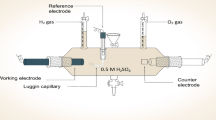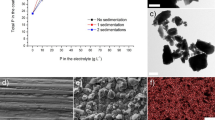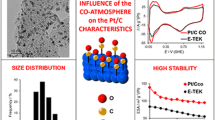Abstract
Platinum–cobalt (Pt–Co) alloy electrocatalysts were prepared on pretreated carbon cloth by electrodeposition from different plating baths with the aim of finding suitable plating bath conditions that could control the chemical composition of the Pt–Co alloy electrodeposits over a wide range (from 0 to 100 at% Pt) and then to study the relationship of the deposit composition on the oxygen reduction reaction (ORR) electroactivity. The type of supporting electrolyte, the solution pH, Pt and Co concentrations of the plating bath and the current density used for electrodeposition all play a crucial role in the composition of the electrodeposited Pt–Co alloy. Pt contents in all the Pt–Co alloys deposited in H2SO4 are at a relatively high and narrow level (83 at%–97 at% Pt), regardless of the electrodeposition conditions used. While the Pt contents in the Pt–Co alloys deposited in Na2SO4 could reach a very low and broad level (5 at%–97 at% Pt), evidence of Co oxide formation is observed. Of the three supporting electrolytes studied, only NaCl effectively produces Pt–Co deposits over a wide range of compositions (8–90 at% Pt) by controlling the Pt and Co concentrations of the plating bath and using the high enough current density. The results show a qualitative correlation between Pt–Co deposit composition and ORR activity, where Pt–Co alloy catalysts with ≥ 45 at% Pt tend to yield higher ORR activities than the pure Pt catalyst, with the best ORR performance obtained from the Pt–Co alloy catalyst with 78 at% Pt.






Similar content being viewed by others
References
de Bruijn F. The current status of fuel cell technology for mobile and stationary applications. Green Chem. 2005;7(3):132.
Wee JH. Applications of proton exchange membrane fuel cell systems. Renew Sustain Energy Rev. 2007;11(8):1720.
Wang Y, Chen KS, Mishler J, Cho SC, Adroher XC. A review of polymer electrolyte membrane fuel cells: technology, applications, and needs on fundamental research. Appl Energy. 2011;88(4):981.
Shao Y, Yin G, Wang Z, Gao Y. Proton exchange membrane fuel cell from low temperature to high temperature: material challenges. J Power Sour. 2007;167(2):235.
Murthi VS, Urian RC, Mukerjee S. Oxygen reduction kinetics in low and medium temperature acid environment: correlation of water activation and surface properties in supported Pt and Pt alloy electrocatalysts. J Phys Chem B. 2004;108(30):11011.
Holton OT, Stevenson JW. The role of platinum in proton exchange membrane fuel cells. Platin Met Rev. 2013;57(4):259.
Larminie J, Dicks A. Fuel Cell Systems Explained. 2nd ed. West Sussex: Wiley; 2003. 48.
Gasteiger HA, Kocha SS, Sompalli B, Wagner FT. Activity benchmarks and requirements for Pt, Pt-alloy, and non-Pt oxygen reduction catalysts for PEMFCs. Appl Catal B. 2005;56(1–2):9.
Sharma S. Recent developments in electrocatalysts and hybrid electrocatalyst support systems for polymer electrolyte fuel cells. In: Maiyalagan T, Saji VS, editors. Electrocatalysts for Low Temperature Fuel Cells: Fundamentals and Recent Trends. Weinheim: Wiley-VCH; 2017. 197.
Stacy J, Regmi N, Leonard B, Fan M. The recent progress and future of oxygen reduction reaction catalysis: a review. Renew Sustain Energy Rev. 2017;69:401.
Jayasayee K, Dam V-AT, Verhoeven T, Celebi S, de Bruijn FA. Oxygen reduction kinetics on electrodeposited PtCo as a model catalyst for proton exchange membrane fuel cell cathodes: stability as a function of PtCo composition. J Phys Chem C. 2009;113(47):20371.
Woo S, Kim I, Lee JK, Bong S, Lee J, Kim H. Preparation of cost-effective Pt–Co electrodes by pulse electrodeposition for PEMFC electrocatalysts. Electrochim Acta. 2011;56(8):3036.
Choi S-I, Lee S-U, Kim WY, Choi R, Hong K, Nam KM, Han SW, Park JT. Composition-controlled PtCo alloy nanocubes with tuned electrocatalytic activity for oxygen reduction. ACS Appl Mater Interfaces. 2012;4(11):6228.
Zhao Y, Liu J, Zhao Y, Wang F. Composition-controlled synthesis of carbonsupported Pt–Co alloy nanoparticles and the origin of their ORR activity enhancement. Phys Chem Chem Phys. 2014;16(36):19298.
Yu P, Pemberton M, Plasse P. PtCo/C cathode catalyst for improved durability in PEMFCs. J Power Sour. 2005;144(1):11.
Neergat M, Shukla AK, Gandhi KS. Platinum-based alloys as oxygen-reduction catalysts for solid-polymer-electrolyte direct methanol fuel cells. J Appl Electrochem. 2001;31(4):373.
M-k Min, Cho J, Cho K, Kim H. Particle size and alloying effects of Pt-based alloy catalysts for fuel cell applications. Electrochim Acta. 2000;45(25–26):4211.
Salgado JRC, Antolini E, Gonzalez ER. Carbon supported Pt70Co30 electrocatalyst prepared by the formic acid method for the oxygen reduction reaction in polymer electrolyte fuel cells. J Power Sour. 2005;141(1):13.
Lu Y, Reddy RG. The electrochemical behavior of cobalt phthalocyanine/platinum as methanol-resistant oxygen-reduction electrocatalysts for DMFC. Electrochim Acta. 2007;52(7):2562.
Aricò AS, Stassi A, Gatto I, Monforte G, Passalacqua E, Antonucci V. Surface properties of Pt and PtCo electrocatalysts and their influence on the performance and degradation of high-temperature polymer electrolyte fuel cells. J Phys Chem C. 2010;114(37):15823.
Paunovic M, Schlesinger M. Fundamentals of Electrochemical Deposition. New York: Wiley; 1998. 6.
Choi KH, Kim HS, Lee TH. Electrode fabrication for proton exchange membrane fuel cells by pulse electrodeposition. J Power Sour. 1998;75(2):230.
Kim H, Subramanian NP, Popov BN. Preparation of PEM fuel cell electrodes using pulse electrodeposition. J Power Sour. 2004;138(1–2):14.
Lee J, Seo J, Han K, Kim H. Preparation of low Pt loading electrodes on Nafion (Na+)-bonded carbon layer with galvanostatic pulses for PEMFC application. J Power Sour. 2006;163(1):349.
Duarte MEE, Pilla AS, Sieben JM, Mayer CE. Platinum particles electrodeposition on carbon substrates. Electrochem Commun. 2006;8(1):159.
Rajalakshmi N, Dhathathreyan KS. Nanostructured platinum catalyst layer prepared by pulsed electrodeposition for use in PEM fuel cells. Int J Hydrog Energy. 2008;33(20):5672.
Zhang H, Zhou W, Du Y, Yang P, Wang C. One-step electrodeposition of platinum nanoflowers and their high efficient catalytic activity for methanol electro-oxidation. Electrochem Commun. 2010;12(7):882.
Chaisubanan N, Tantavichet N. Pulse reverse electrodeposition of Pt–Co alloys onto carbon cloth electrodes. J Alloys Compd. 2013;559:69.
Mikhaylova AA, Khazova OA, Bagotzky VS. Electrocatalytic and adsorption properties of platinum microparticles electrodeposited onto glassy carbon and into Nafion® films. J Electroanal Chem. 2000;480(1–2):225.
Thompson SD, Jordan LR, Forsyth M. Platinum electrodeposition for polymer electrolyte membrane fuel cells. Electrochim Acta. 2001;46(10–11):1657.
Selvaraju T, Ramaraj R. Electrochemically deposited nanostructured platinum on Nafion coated electrode for sensor applications. J Electroanal Chem. 2005;585(2):290.
Domínguez-Domínguez S, Arias-Pardilla J, Berenguer-Murcia Á, Morallón E, Cazorla-Amorós D. Electrochemical deposition of platinum nanoparticles on different carbon supports and conducting polymers. J Appl Electrochem. 2008;38(2):259.
Martín AJ, Chaparro AM, Gallardo B, Folgado MA, Daza L. Characterization and single cell testing of Pt/C electrodes prepared by electrodeposition. J Power Sour. 2009;192(1):14.
Li J, Ye F, Chen L, Wang T, Li J, Wang X. A study on novel pulse preparation and electrocatalytic activities of Pt/C-Nafion electrodes for proton exchange membrane fuel cell. J Power Sour. 2009;186(2):320.
Alcaide F, Álvarez G, Blázquez JA, Cabot PL, Miguel O. Development of a novel portable-size PEMFC short stack with electrodeposited Pt hydrogen diffusion anodes. Int J Hydrog Energy. 2010;35(11):5521.
Liu J, Zhong C, Du X, Wu Y, Xu P, Liu J, Hu W. Pulsed electrodeposition of Pt particles on indium tin oxide substrates and their electrocatalytic properties for methanol oxidation. Electrochim Acta. 2013;100:164.
Le Vot S, Roué L, Bélanger D. Study of the electrochemical oxidation of ammonia on platinum in alkaline solution: effect of electrodeposition potential on the activity of platinum. J Electroanal Chem. 2013;691:18.
Fouda-Onana F, Guillet N, AlMayouf AM. Modified pulse electrodeposition of Pt nanocatalyst as high-performance electrode for PEMFC. J Power Sour. 2014;271:401.
Jyoko Y, Schwarzacher W. Characterization of electrodeposited magnetic Co/Pt multilayered nanostructures. Electrochim Acta. 2001;47(1–2):371.
Coutanceau C, Rakotondrainibé AF, Lima A, Garnier E, Pronier S, Léger J-M, Lamy C. Preparation of Pt–Ru bimetallic anodes by galvanostatic pulse electrodeposition: characterization and application to the direct methanol fuel cell. J Appl Electrochem. 2004;34(1):61.
Martín AJ, Chaparro AM, Daza L. Electrochemical quartz crystal microbalance study of the electrodeposition of Co, Pt and Pt–Co alloy. J Power Sour. 2007;169(1):65.
Liu J, Cao L, Huang W, Li Z. Direct electrodeposition of PtPd alloy foams comprised of nanodendrites with high electrocatalytic activity for the oxidation of methanol and ethanol. J Electroanal Chem. 2012;686(1):38.
Zhao W, Yang Y, Zhang H. Electrodeposition preparation of highly dispersed Pt/HxWO3 composite catalysts for PEMFCs. Electrochim Acta. 2013;99:273.
Zhang J, Li D, Zhu Y, Chen M, An M, Yang P, Wang P. Properties and electrochemical behaviors of AuPt alloys prepared by direct-current electrodeposition for lithium air batteries. Electrochim Acta. 2013;151:415.
Leistner K, Oswald S, Thomas J, Fähler S, Schlörb H, Schultz L. Potential dependence of composition and structure of electrodeposited Fe–Pt films. Electrochim Acta. 2006;52(1):194.
Hwang SM, Lee CH, Kim JJ, Moffat TP. Oxygen reduction reaction on electrodeposited Pt100−x−yNixPdy thin films. Electrochim Acta. 2010;55(28):8938.
Ra Y, Lee J, Kim I, Bong S, Kim H. Preparation of Pt–Ru catalysts on Nafion(Na+)-bonded carbon layer using galvanostatic pulse electrodeposition for proton-exchange membrane fuel cell. J Power Sour. 2009;187(2):363.
Jayasayee K, Van Veen JAR, Hensen EJM, de Bruijn FA. Influence of chloride ions on the stability of PtNi alloys for PEMFC cathode. Electrochim Acta. 2011;56(20):7235.
Lertviriyapaisan S, Tantavichet N. Sublayers for Pt catalyst electrodeposition electrodes in PEMFC. Int J Hydrog Energy. 2010;35(19):10464.
Lopes T, Antolini E, Colmati F, Gonzalez ER. Carbon supported Pt–Co (3:1) alloy as improved cathode electrocatalyst for direct ethanol fuel cells. J Power Sour. 2007;164(1):111.
Zhang X, Chan KY. Microemulsion synthesis and electrocatalytic properties of platinum–cobalt nanoparticles. J Mater Chem. 2002;100(4):1203.
Travitsky N, Ripenbein T, Golodnitsky D, Rosenberg Y, Burshtein L, Peled E. Pt-, PtNi- and PtCo-supported catalysts for oxygen reduction in PEM fuel cells. J Power Sour. 2006;161(2):782.
Xiong L, Manthiram A. Nanostructured Pt–M/C (M = Fe and Co) catalysts prepared by a microemulsion method for oxygen reduction in proton exchange membrane fuel cells. Electrochim Acta. 2005;50(11):2323.
Luo J, Njoki PN, Lin Y, Wang L, Zhong CJ. Activity-composition correlation of AuPt alloy nanoparticle catalysts in electrocatalytic reduction of oxygen. Electrochem Commun. 2006;8(4):581.
Jeon MK, Zhang Y, McGinn PJ. A comparative study of PtCo, PtCr, and PtCoCr catalysts for oxygen electro-reduction reaction. Electrochim Acta. 2010;55(19):5318.
Ye JH, Fedkiw PS. Electrodeposition of high-surface area platinum in a well adherent nafion film on glassy carbon. Electrochim Acta. 1996;41(2):221.
Paulus UA, Schmidt TJ, Gasteiger HA, Behm RJ. Oxygen reduction on a high-surface area Pt/Vulcan carbon catalyst: a thin-film rotating ring-disk electrode study. J Electroanal Chem. 2001;495(2):134.
Paulus UA, Wokaun A, Scherer GG, Schmidt TJ, Stamenkovic V, Markovic NM, Ross PN. Oxygen reduction on high surface area Pt-based alloy catalysts in comparison to well defined smooth bulk alloy electrodes. Electrochim Acta. 2002;47(22):3787.
Mo Y, Sarangapani S, Le A, Scherson DA. Electrochemical characterization of unsupported high area platinum dispersed on the surface of a glassy carbon rotating disk electrode in the absence of Nafion® or other additives. J Electroanal Chem. 2002;538–539:35.
Liu Z, Gan LM, Hong L, Chen W, Lee JY. Carbon-supported Pt nanoparticles as catalysts for proton exchange membrane fuel cells. J Power Sour. 2005;139(1–2):73.
Plyasova LM, Molina IYU, Gavrilov AN, Cherepanova SV, Cherstiouk OV, Rudina NA, Savinova ER, Tsirlina GA. Electrodeposited platinum revisited: tuning nanostructure via the deposition potential. Electrochim Acta. 2006;51(21):4477.
Wang R, Li H, Ji S, Wang H, Lei Z. Pt decorating of PdNi/C as electrocatalysts for oxygen reduction. Electrochim Acta. 2010;55(5):1519.
Punyawudho K, Blom DA, Van Zee JW, Monnier JR. Comparison of different methods for determination of Pt surface site concentrations for supported Pt electrocatalysts. Electrochim Acta. 2010;55(19):5349.
Ohashi M, Beard KD, Ma S, Blom DA, St-Pierre J, Van Zee JW, Monnier JR. Electrochemical and structural characterization of carbon-supported Pt–Pd bimetallic electrocatalysts prepared by electroless deposition. Electrochim Acta. 2010;55(24):7376.
Chen D, Tao Q, Liao LW, Liu SX, Chen YX, Ye S. Determining the active surface area for various platinum electrodes. Electrocatalysis. 2011;2(3):207.
Zhang S, Chen S. Enhanced-electrocatalytic activity of Pt nanoparticles supported on nitrogen-doped carbon for the oxygen reduction reaction. J Power Sour. 2013;240:60.
Geboes B, Ustarroz J, Sentosun K, Vanrompay H, Hubin A, Balsand S, Breugelmans T. Electrochemical behavior of electrodeposited nanoporous Pt catalysts for the oxygen reduction reaction. ACS Catal. 2016;6(9):5856.
Perez J, Gonzalez ER, Ticianelli EA. Oxygen electrocatalysis on thin porous coating rotating platinum electrodes. Electrochim Acta. 1998;44(8–9):1329.
Van Brussel M, Kokkinidis G, Hubin A, Buess-Herman C. Oxygen reduction at platinum modified gold electrodes. Electrochim Acta. 2003;48(25–26):3909.
Benítez R, Chaparro AM, Daza L. Electrochemical characterisation of Pt/C suspensions for the reduction of oxygen. J Power Sour. 2005;151:2.
Stamenkovic VR, Mun BS, Arenz M, Mayrhofer KJJ, Lucas CA, Wang G, Ross PN, Markovic NM. Trends in electrocatalysis on extended and nanoscale Pt-bimetallic alloy surfaces. Nat Mater. 2007;6(3):241.
Viswanathan V, Hansen HA, Rossmeisl J, Nørskov JK. Universality in oxygen reduction electrocatalysis on metal surfaces. ACS Catal. 2012;2(8):1654.
Mukerjee S, Srinivasan S. Enhanced electrocatalysis of oxygen reduction on platinum alloys in proton exchange membrane fuel cells. J Electroanal Chem. 1993;357(1–2):201.
Salgado RC, Antolini E, Gonzalez ER. Structure and activity of carbon-supported Pt–Co electrocatalysts for oxygen reduction. J Phys Chem B. 2004;108(46):17767.
Koh S, Toney MF, Strasser P. Activity–stability relationships of ordered and disordered alloy phases of Pt3Co electrocatalysts for the oxygen reduction reaction (ORR). Electrochim Acta. 2007;52(8):2765.
Stamenkovic VR, Mun BS, Arenz M, Mayrhofer KJJ, Lucas CA, Wang GF, Ross PN, Markovic NM. Trends in electrocatalysis on extended and nanoscale Pt-bimetallic alloy surfaces. Nat Mater. 2007;6(3):241.
Bard AJ, Faulkner LR. Electrochemical Methods—Fundamentals and Applications. 2nd ed. New York: Wiley; 2001. 341.
Park JH, Sohn Y, Jung DH, Kim P, Joo JB. Pt deposited Pt–Pd/C electrocatalysts with the enhanced oxygen reduction activity. J Ind Eng Chem. 2016;36:109.
Acknowledgements
This project was financially supported by the Ratchadapisek Sompoch Endowment Fund, Chulalongkorn University (Sci-Super 2014-026), the Thailand Research Fund (TRF IRG5780001) and the Faculty of Science, Chulalongkorn University.
Author information
Authors and Affiliations
Corresponding author
Rights and permissions
About this article
Cite this article
Puangsombut, P., Tantavichet, N. Effect of plating bath composition on chemical composition and oxygen reduction reaction activity of electrodeposited Pt–Co catalysts. Rare Met. 38, 95–106 (2019). https://doi.org/10.1007/s12598-018-1082-2
Received:
Revised:
Accepted:
Published:
Issue Date:
DOI: https://doi.org/10.1007/s12598-018-1082-2




